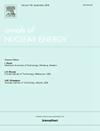Magnetohydrodynamic (MHD) effects on conjugate mixed convection in a triangular enclosure with swirling reactive fluid: A computational approach
IF 1.9
3区 工程技术
Q1 NUCLEAR SCIENCE & TECHNOLOGY
引用次数: 0
Abstract
In this research, we investigate the quantitative characteristics of conjugate mixed convection heat transfer, internal heat generation/absorption due to chemical reaction and the magnetohydrodynamic impact on a lid-driven right-angled triangular enclosure which has a solid circular cylinder situated at the center. The perpendicular edges of the enclosure remain stationary and maintain a constant cold temperature. The tilted side is adiabatic, while the bottom edge slides uniformly, maintaining a constant elevated temperature. The solid cylinder was rotated at different angular velocities in clockwise and counterclockwise directions while applying a constant magnetic field to the enclosure. By varying the Reynolds (31.623 ≤ Re ≤ 316.23), Richardson (0.1 ≤ Ri ≤ 10), Grashof number (103 ≤ Gr ≤ 105), internal heat generation or absorption coefficient (−10 ≤ Δ ≤ 10), and the rotating cylinder’s speed (−2 ≤ Rec ≤ 2) along with a given magnetohydrodynamic effect of the cylinder, parametric simulation is used. Plots of streamlines and isotherms are used to depict qualitative results. In contrast, the average Nusselt number, normalized Nusselt number, and average drag coefficient are used to calculate the configuration’s quantitative thermal performance and flow characteristics. To the best of our knowledge, this study is the first to present a comprehensive numerical investigation of conjugate heat transfer in a lid-driven triangular enclosure that simultaneously considers: (1) magnetohydrodynamic effects, (2) both clockwise and counterclockwise rotation of an internal solid cylinder, and (3) internal heat generation and absorption. The results reveal a strong interactive influence among these factors. Most notably, internal heat absorption enhances the average Nusselt number by up to 74.5 % and reduces the average drag coefficient by 89 % when both Reynolds and Grashof numbers are at their maximum values. Parallel to this, streamline and isotherm plots show overall heat distribution and flow separation within the enclosure. The simulations clearly show that higher Reynolds and Grashof numbers, combined with internal heat absorption, markedly enhance heat transfer, while the effect of cylinder rotation remains relatively minor.
具有旋流反应流体的三角形外壳中共轭混合对流的磁流体动力学效应:一种计算方法
在这项研究中,我们研究了共轭混合对流换热的定量特性,由于化学反应引起的内部热产生/吸收以及磁流体动力对位于中心的实心圆柱体的直角三角形外壳的影响。外壳的垂直边缘保持静止,并保持恒定的低温。倾斜的一面是绝热的,而底部边缘均匀滑动,保持恒定的升高温度。固体圆柱体在顺时针和逆时针方向以不同的角速度旋转,同时对外壳施加恒定的磁场。通过改变雷诺数(31.623≤Re≤316.23)、理查德森数(0.1≤Ri≤10)、Grashof数(103≤Gr≤105)、内部产热或吸收系数(−10≤Δ≤10)、旋转圆柱体转速(−2≤Rec≤2)以及给定的圆柱体磁流体力学效应,进行参数化仿真。流线和等温线图用于描述定性结果。利用平均努塞尔数、归一化努塞尔数和平均阻力系数来计算构型的定量热性能和流动特性。据我们所知,这项研究首次对盖子驱动的三角形外壳中的共轭传热进行了全面的数值研究,同时考虑了:(1)磁流体动力学效应,(2)内部固体圆柱体的顺时针和逆时针旋转,以及(3)内部热量的产生和吸收。结果表明,这些因素之间存在很强的交互影响。最值得注意的是,当雷诺数和格拉什夫数均达到最大值时,内部吸热使平均努塞尔数提高了74.5%,平均阻力系数降低了89%。与此平行,流线和等温线图显示了外壳内的整体热量分布和流动分离。模拟结果表明,较高的雷诺数和格拉什夫数,加上内部吸热,显著增强了换热,而圆柱旋转对换热的影响相对较小。
本文章由计算机程序翻译,如有差异,请以英文原文为准。
求助全文
约1分钟内获得全文
求助全文
来源期刊

Annals of Nuclear Energy
工程技术-核科学技术
CiteScore
4.30
自引率
21.10%
发文量
632
审稿时长
7.3 months
期刊介绍:
Annals of Nuclear Energy provides an international medium for the communication of original research, ideas and developments in all areas of the field of nuclear energy science and technology. Its scope embraces nuclear fuel reserves, fuel cycles and cost, materials, processing, system and component technology (fission only), design and optimization, direct conversion of nuclear energy sources, environmental control, reactor physics, heat transfer and fluid dynamics, structural analysis, fuel management, future developments, nuclear fuel and safety, nuclear aerosol, neutron physics, computer technology (both software and hardware), risk assessment, radioactive waste disposal and reactor thermal hydraulics. Papers submitted to Annals need to demonstrate a clear link to nuclear power generation/nuclear engineering. Papers which deal with pure nuclear physics, pure health physics, imaging, or attenuation and shielding properties of concretes and various geological materials are not within the scope of the journal. Also, papers that deal with policy or economics are not within the scope of the journal.
 求助内容:
求助内容: 应助结果提醒方式:
应助结果提醒方式:


